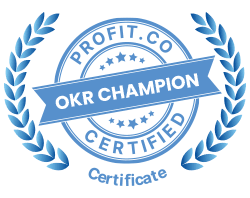Listen and follow
Introduction
OKR vs. MBO? At first glance, the differences between OKR (Objectives and Key Results) and MBO (Management by Objectives) may not be immediately apparent. However, OKRs have proven to be a more robust and adaptable evolution of MBO, which is why major companies have adopted it.
Both frameworks share common principles:
- Focus on organizational alignment
- Goal-oriented methodologies
- Worker-centric approaches
- Progress monitoring
- Recognition and acknowledgment of achievements
So, what’s the difference? Let’s explore MBO’s deficiencies and how OKRs build on them to bring more structure, focus, and discipline.
New to OKR? See our introduction – “What is OKR?”

What’s Wrong with MBO?
The principles of MBO are solid, and many companies have implemented it with good results. However, as an early pioneer of goal-oriented management (introduced by Peter Drucker in 1954), it is understandable that some gaps have emerged over time.
MBO’s core idea, setting goals is valuable, but organizations often neglect its other essential principles. This inconsistency has led to issues that OKR addresses and refines. Here’s how:

OKRs tighten the loose ends.

1. OKRs Encourage Shorter Planning Periods
MBO is frequently criticized for its annual planning cycles. Over a year, it’s easy to lose focus, drift off track, or miss opportunities to adapt to changing market conditions.
OKRs solve this with shorter, quarterly planning cycles. These encourage focused goal-setting, regular evaluations, and the agility to adjust strategies as needed. With OKRs, goals are always visible and within reach, fostering better planning and adaptability.


2. OKRs Reinforce People Power
While MBO advocates employee inclusion in the planning process, top-down management styles have often diluted this principle.
OKRs re-emphasize employee involvement through practices like 1-on-1 meetings, Conversations, Feedback, and Recognition (CFR), and self-evaluations. This approach ensures the worker remains at the center of the goal-setting and execution process.


3. Centralized Progress Reporting for Accountability
MBO lacks a defined process or frequency for reporting progress.
In contrast, OKRs prioritize centralized progress reporting. Studies show that workers are more motivated and productive when everyone’s progress is visible organization-wide. Transparency fosters accountability and drives results.


4. Discipline and Cadence Built into OKRs
MBO does not emphasize regular check-ins outside of formal semi-annual or annual reviews.
OKRs introduce a rhythm of discipline through shorter cycles and consistent touchpoints:
- Pre-quarter planning
- Weekly progress updates via a central platform
- Monthly 1-on-1 meetings
- Post-quarter self-evaluations
This structured cadence transforms OKRs into a cultural habit—much like exercise. It requires discipline, but the results are transformative.

5. OKRs Drive Growth and Innovation
OKRs introduce the concept of “stretch goals”—targets that push individuals and teams beyond their comfort zones to achieve more. These goals inspire everyone to aim for better quality, faster results, and increased growth.
With an entire organization adopting a “stretch” mindset, innovation flourishes, and ambitious objectives become attainable.

6. OKRs Foster Departmental Collaboration
MBO primarily focuses on manager-worker planning and individual achievements.
OKRs build on this by emphasizing the bigger picture, promoting cross-departmental collaboration, communication, and alignment. This approach strengthens teamwork and drives collective success.

Conclusion: OKR vs. MBO—Focus, Discipline, and Growth
MBO is a strong methodology with a solid foundation, but over time its limitations have become evident. OKRs refine and expand on MBO principles, introducing structure, discipline, and transparency, while fostering growth and innovation.
Though statistics on OKR usage stats are not available, a 2024 article says that Google trends has shown an 11-fold increase in OKR search traffic in the last 10 years (https://mooncamp.com/blog/okr-statistics#okr-statistics-use-of-okrs).
Also, adaption of OKR by major companies like Google, Netflix, Microsoft, Amazon among others attests to the extraordinary effectiveness of OKR strategies in management.
Look who’s using OKRs!


Find out about our OKR Services









0 Comments